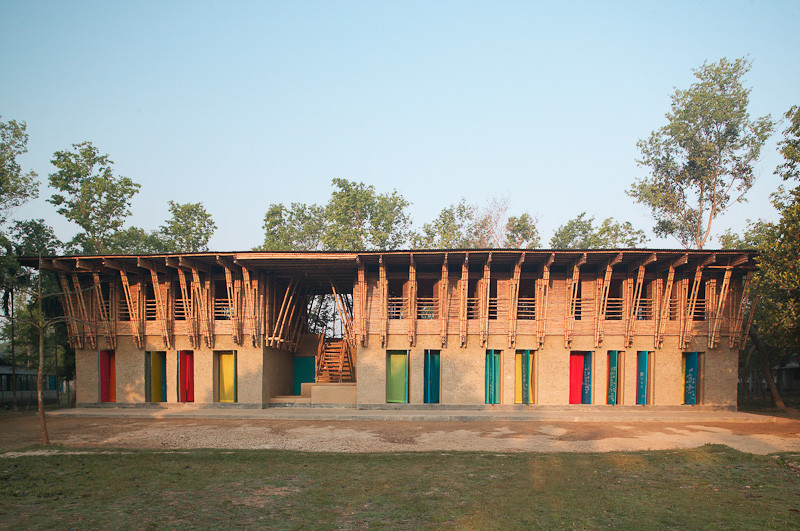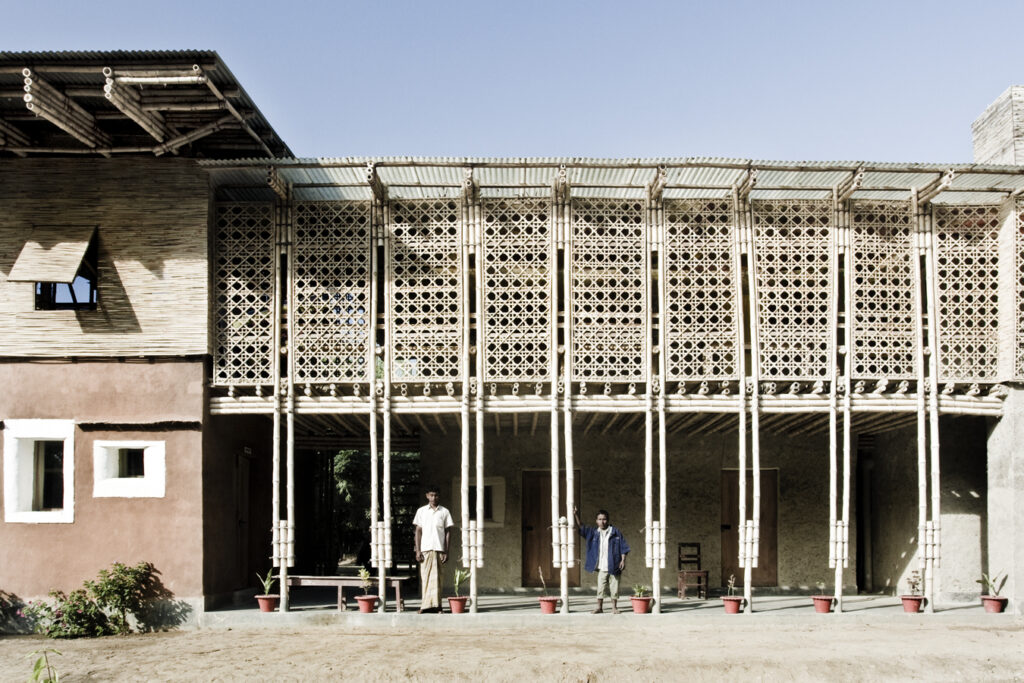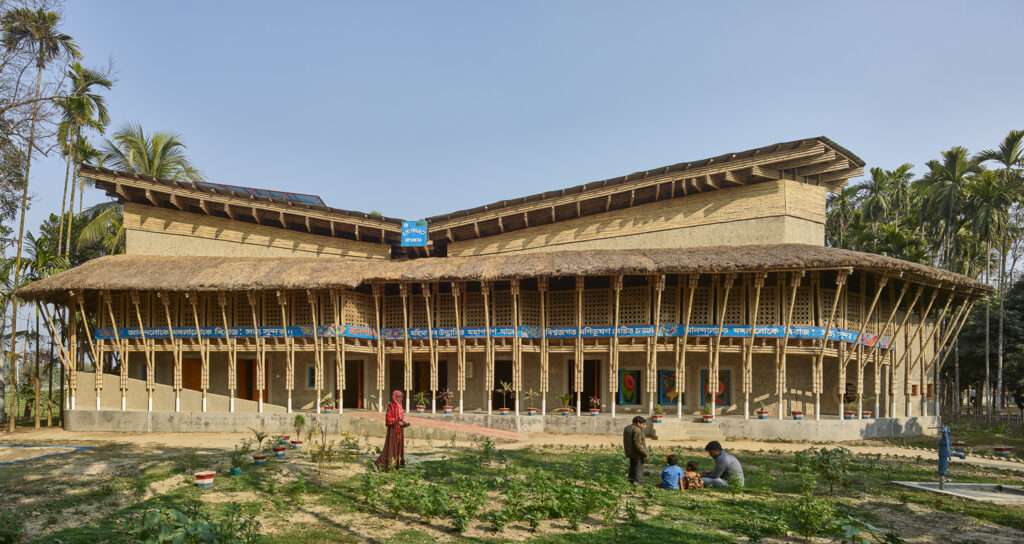Photo: Martin Mackowitz
Unlock Premium, Members-Only Content
Your source for the most relevant updates in sustainable construction
Anna Heringer is more than just an architect. She’s a visionary who molds mud and bamboo into sustainable masterpieces. Let’s dive into her world, exploring her roots, her philosophy, and her groundbreaking projects that redefine what buildings can be and do.
Anna Heringer Biographical Background
Anna Heringer: Early Influences and Architectural Education
Born in Germany, raised near Salzburg, Anna’s journey into architecture began with a profound connection to the landscapes of her childhood. At 19, a pivotal year living and working in Bangladesh imprinted upon her a deep respect for local materials and traditional techniques, setting the stage for a career built on the principles of sustainability and community participation.
Key Experiences Shaping Her Approach
Heringer’s experience in Bangladesh was transformative, leading her to champion low-tech, high-impact solutions in architecture. Her approach isn’t just about buildings; it’s about building up people and communities.
Anna Heringer and her Philosophy of Sustainable Design
Anna Heringer’s architectural philosophy integrates deep respect for the natural world with a commitment to enhancing human well-being through sustainable practices. She famously asserts, “Sustainability is a synonym of beauty.” This statement encapsulates her belief that true beauty in architecture does not solely stem from visual aesthetics but rather from the profound harmony between the building and its broader environment—socially, culturally, and ecologically.
The Interconnection of Aesthetics and Sustainability
For Anna, an architecturally beautiful structure achieves a balance that reflects the local environment’s needs while enhancing it. This balance involves using construction materials that are locally sourced, thereby reducing environmental impact and bolstering local economies. Each project she undertakes serves as a case study in minimizing carbon footprints and maximizing local artisan skills and materials, proving that sustainable practices can lead to aesthetically remarkable and functional buildings.
- Material Selection: Choosing local materials not only supports the local economy but also decreases the environmental costs associated with transportation and manufacturing of non-local materials.
- Design Philosophy: Her design philosophy revolves around the integration of the building into its setting, making each structure uniquely suited to its location and cultural context.
Enhancing Socio-cultural Contexts
Anna’s projects are meticulously designed to respect and uplift the socio-cultural environments they inhabit. By engaging local communities in the building process, her designs do more than occupy space—they become woven into the fabric of the community’s daily life and practices. This involvement helps preserve traditional building techniques and promotes a sense of ownership and pride among local residents.
- Community Involvement: Active participation from the community in the construction process helps preserve traditional skills and promotes a sustainable model of development that benefits all stakeholders.
- Socio-cultural Enhancement: Her buildings are designed to be more than just structures; they are active community centers that promote social interaction and cultural exchange.
Anna Heringer and Environmental Integration
Anna’s approach extends beyond using sustainable materials; it includes creating buildings that live and breathe with their surroundings. This means designing structures that are not only environmentally friendly but also enhance the local habitat.
- Ecological Impact: Every project is evaluated for its environmental impact, aiming to enhance rather than deplete the local ecological balance.
- Innovative Techniques: The use of advanced sustainable technologies and methodologies, such as passive solar design, natural cooling, and green roofs, further illustrates her commitment to eco-friendly architecture.
Emphasizing Local Materials and Community Involvement
Why import when you can support local economies? Anna’s projects extensively use materials that are locally available, like earth and bamboo, which are often underrated yet abundantly sustainable. By doing so, she not only conserves resources but also empowers local communities by involving them in the building process, thus fostering a sense of ownership and pride.
Anna Heringer: Highlight Projects
Anna Heringer’s portfolio brims with innovative projects, each telling a story of community, sustainability, and creativity. Let’s look at a few:
METI School, Bangladesh

- Location: Rudrapur, Bangladesh
- Completed: 2006
- Materials Used: Mud, bamboo
- Impact: Focuses on vocational training and uses architecture as a tool to boost local skills and economy.
The METI School is a testament to the power of traditional materials when combined with innovative architectural techniques. It’s a place of learning, both academically and architecturally.
DESI Vocational School

Photo: Naquib Hossain, B.K.S. Inan
- Unique Feature: First mud-built structure in Bangladesh with indoor plumbing.
- Sustainability Aspect: Uses solar power and natural materials.
- Community Impact: Enhances local craftsmanship and reduces rural to urban migration by providing local job opportunities.
Anandaloy Building

Photo: Kurt Hoerbst, Stefano Mori
- Location: Northern Bangladesh
- Dual Purpose: Combines a center for people with disabilities with a textile studio.
- Architectural Note: The building’s structure promotes inclusivity and provides economic opportunities through its textile studio.
Each project embodies Anna’s belief that architecture should serve as a catalyst for social change, proving that good design goes beyond looks—it’s about impact and sustainability.
This glimpse into Anna Heringer’s life and work highlights her role as a pioneer in sustainable architecture, merging functionality with environmental empathy to create spaces that truly belong to their community.
Anna Heringer: Community and Educational Impact
Anna Heringer’s architectural projects transcend the traditional boundaries of building by serving as vital educational tools and hubs for community development. These projects are not just constructions but are transformative spaces that educate, empower, and elevate the communities they are built within.
Educational Outreach Through Architecture
Anna’s buildings are classrooms not only in form but in function. The METI School in Bangladesh, for instance, is a place where students learn vocational skills in an environment built using the very techniques taught within its walls. This hands-on approach ensures that learning transcends theoretical knowledge, embedding practical skills and sustainability concepts directly into the curriculum.
- METI School’s Impact: Provides education and practical training in sustainable building techniques to local students.
- Curriculum Integration: Courses include traditional craftsmanship, empowering students with skills that are economically and environmentally sustainable.
Fostering Community Engagement and Development
Each of Anna’s projects is designed with the dual purpose of functionality and community development. For example, the Anandaloy Building not only serves as a therapy center for people with disabilities but also houses a textile studio that employs local women, thus providing them with both a livelihood and a social support network. This dual-use approach creates a ripple effect of benefits, enhancing both economic stability and social cohesion within the community.
- Anandaloy Building’s Role: A center for disability support and economic development through textile production.
- Community Benefits: Increased employment opportunities and social integration for marginalized groups.
Anna Heringer and the Future Directions in Architecture
As the world leans more towards sustainability, the work of architects like Anna Heringer becomes increasingly crucial. Her approach provides a blueprint for future developments in architecture, emphasizing not only the environmental but also the social aspects of sustainability.
Anna Heringer Trends Shaping Sustainable Architecture
The global architecture community is gradually embracing the principles Anna has championed: using local materials, engaging local communities in the construction process, and designing with an eye towards minimal environmental impact. These trends are likely to shape the future of building worldwide, making architecture a key player in sustainable development efforts.
- Global Influence: How Anna’s projects inspire similar sustainable practices worldwide.
- Innovative Materials and Techniques: Exploration of new, sustainable materials and building techniques that could revolutionize how we build.
Anna Heringer’s Vision for the Future
Looking ahead, Anna Heringer’s vision for architecture involves a deeper integration of ecological, economic, and social sustainability. She advocates for buildings that are not only constructed with sustainable materials but are also designed to significantly enhance the quality of life for their users. Her future projects, and the principles they embody, are set to inspire a new generation of architects to think differently about how and why we build.
- Sustainable Living Models: Potential projects and ideas that exemplify sustainable living.
- Educational Initiatives: Ongoing and future educational programs aimed at spreading sustainable architectural practices globally.
Through these initiatives, Anna Heringer is not just shaping the physical landscapes but also the conceptual foundations of future architecture, fostering a world where buildings help create a more sustainable, inclusive, and interconnected society.
Awards and Recognition
Anna Heringer’s work has not only redefined architectural norms but has also garnered international acclaim. Her commitment to sustainable and socially-responsible architecture has been recognized through numerous prestigious awards, highlighting her influence in the field.
Anna Heringer Key Awards
- Aga Khan Award for Architecture (2007): Awarded for the METI School in Bangladesh, this accolade recognized the project’s innovative use of traditional materials and its impact on local education.
- Global Award for Sustainable Architecture (2011): This award celebrated Anna’s holistic approach to sustainability that integrates ecological balance with cultural and social dimensions.
- Obel Award (2020): Anna received this for the Anandaloy Building, which combines disability support with local craft promotion in Bangladesh, demonstrating a multifaceted approach to community-centric sustainable architecture.
Anna Heringer: Impact of These Recognitions
Each award has helped to cement Anna Heringer’s reputation as a pioneer in sustainable architecture. These accolades not only honor her past achievements but also validate her methods and philosophy, encouraging more architects to consider sustainability as a core aspect of design. This recognition also helps attract more significant projects and opportunities, expanding her influence and allowing her to implement her ideals on larger scales.
- List of Awards: A comprehensive table of awards Anna has won, along with brief descriptions of the projects for which she won them.
- Testimonials: Insights from industry experts and collaborators on the impact of Anna’s work and what these awards mean for the field of architecture.
Conclusion
Anna Heringer’s approach to architecture transcends mere construction. Her work is a manifesto for a future where buildings harmonize with their environment and enrich the communities around them. By focusing on sustainable materials and inclusive design principles, she not only creates functional spaces but also fosters social and economic growth.
Anna Heringer’s work reminds us that architecture is not just about creating spaces but about shaping the human experience and preserving the world for future generations. Through her innovative use of materials and her commitment to social values, she continues to inspire and lead in the field of sustainable architecture.
If you want o learn about our consultancies in Portuguese language, click here.
Unlock Premium, Members-Only Content
Your source for the most relevant updates in sustainable construction